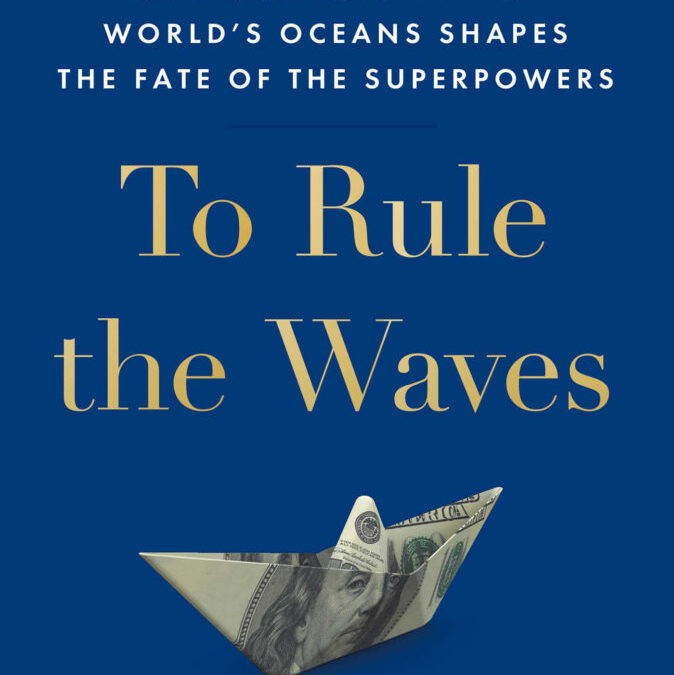BY STAS MARGARONIS
Last November International Propeller Club president James Patti, warned that a lack of U.S. flag shipping has made the United States vulnerable to the increasing economic dominance of China. He also warned that a lack of investment in the nation’s maritime infrastructure was making a bad situation worse.
Patti, who also also serves as the chair of USA Maritime, a coalition representing U.S.-flag shipping companies and maritime unions argued that the United States needs to:[1]
* Build up its merchant fleet to compete in international trade.
* Increase investment in ports.
* Expand construction of coastal ships and tug/barges to carry more domestic freight by water.
He noted: “It is no secret that China has embarked on an aggressive and incredibly well-coordinated strategy to enhance its maritime presence and control and to increase its share of the world’s waterborne trade.”
The United States must increase its share of the international shipping trade or face the consequences: “Unless our nation acts to increases its share of cargo carried by our vessels, we shall find ourselves at the mercy of such vessel operations and subject to their economic blackmail and coercion.”
According to the Washington-based Center for Strategic and International Studies (CSIS) report “Hidden Harbors: China’s State-backed Shipping Industry,” China has made unprecedented investments to dominate the global maritime industry with the result that Chinese companies:
* Control the world’s second-largest shipping fleet by gross tons and constructing over a third of the world’s vessels in 2019.
* Produce 96 percent of the world’s shipping containers.
* Produce more than 80 percent of the world’s ship-to-shore cranes.
* Own seven of the ten busiest ports in the world (including Hong Kong).[2]
Patti said the U.S. maritime decline occurs as China has made massive investments in its infrastructure as Bruce Jones describes in his new book “To Rule the Waves: How Control of the World’s Ocean Shapes the Fate of the Superpowers”[3]
Jones is a Senior Fellow at the Brookings Institute, a Washington, DC think tank. He travelled extensively to China to research his book and used the Port of Shanghai as one example of the rise of China as a maritime and naval power. He spoke to the Propeller Club of Northern California on January 18th.
Jones discussed the importance and symbolism of the new Yangshan offshore container terminal complex serving Shanghai. Yangshan is linked to Shanghai by a 30-kilometer bridge.[4] This complex makes Shanghai the largest port in the world having processed 43.5 million twenty-foot container units (teus) in 2020.
This compares to 9 million teus by the Port of Los Angeles the largest port in the United States and placed Los Angeles in 17th place among world ports, according to the World Shipping Council.[5]
The differential between U.S infrastructure spending and China’s larger investments can also be understood in another example.
The infrastructure bill supported by the Biden Administration and enacted into law by Congress in 2021 contains $17 billion for all U.S. ports, according to the Administration’s Port Envoy John Porcari.
The price tag for China building the Yangshan port complex was $18 billion.[6]
The next largest ports in the world after Shanghai/Yangshan are:
No. 2 Singapore
No. 3 Ningbo, China
No. 4 Shenzhen, China
No. 5 Guangzhou, China
Jones says the investments China makes in its ports contributes to its leadership in world trade. China’s success includes building up its manufacturing and industrial base resulting in trade surpluses with the United States.
At a time when U.S. global carriers such as Sealand and American President Lines have disappeared, China has built up China Ocean Shipping Company (COSCO) to becomes the fourth largest ocean container carrier in the world. COSCO operates in over 40 countries with a fleet of around 480 container ships and a container carrying capacity of 2,932,779 teus.[7]
According to the Journal of Commerce, COSCO Shipping Holdings “has placed a $1.5 billion order for 10 new container ships, extending the carrier’s on-order capacity to almost 15 percent of its in-service fleet.”
China has also become the world’s leader in shipbuilding.
In 2021, China had taken the number-one spot in shipbuilding, overtaking South Korea for annual order volume in compensated gross tons (CGT), according to data released by Clarksons and reported in Marine-Executive.
In 2021, China’s shipbuilders won orders of about 22.8 million CGT, almost exactly 50 percent of the global total of 45.7 million. South Korean builders took in orders totaling 17.5 million CGT, or about 38 percent.
China dominated in sales of new container ships, a segment which has taken off thanks to a surge in demand for its consumer goods cargo. In South Korea, the nation’s leading shipbuilders have emphasized sales of high-margin, high-value LNG carriers, which have better profitability.”[8]
By contrast, the United Sates is a miniscule shipbuilder, as reflected in a Forbes Magazine report:
“A nation that was among the world’s leaders in commercial shipbuilding at key junctures in its history today builds less than 10 vessels for oceangoing commerce in a typical year.
China builds over a thousand such ships each year.
The entire U.S.-registered fleet of oceangoing commercial ships numbers fewer than 200 vessels, out of a global total of 44,000.
And despite trade flows to and from America exceeding a trillion dollars annually—the vast preponderance of which travel by sea—U.S.-registered ships carry barely 1% of that traffic.”[9]
Jones described how every continent of the world is connected by global trade ties and “what this reflects is the value of trade as a share of global GDP … which exploded in the 1980s and 1990s.”
Today, he says: “Eighty-five percent of all trade moves by sea … That huge scale in the scale of global shipping leads to this dramatic decline in trade costs over the period of the last seventy years. “
Jones notes that “that huge decline in the cost of transportation is really the critical factor in enabling China to participate in globalization in the 1990s and the 2000s … and what you see is the inexorable rise of China in the participation of global trade signified by the scale of ports … and the huge growth of Chinese ports. Back in the 1980s and 1990s all the largest ports are in the West and if you fast-forward to the present day … you have ports like Yangshan that are” nearly five times larger” than their nearest American competitors.”
Meanwhile, in the United States “this is a critical time when we are essentially falling out of the shipbuilding business, we are disinvesting in port infrastructure …. we are not in the infrastructurer of world trade. China takes over as the infrastructurer of world trade.”
As China has developed economically, it has begun to build up its naval presence to protect and extend its global reach.
In the 1990s and 2000s, Jones said, China realized how its economy was increasingly dependent on imports of raw materials and in turn, this situation required that it protect its sea lanes through the South China Sea and East China Sea and into Chinese ports. At the same time, China relies on the sea lanes “with exports of finished goods out going through the same route and with Chinese industrial centers linked to the ports.”
China’s policy-makers have concluded that the U.S. Navy poses a threat to China’s trade lanes and could blockade Chinese ports in a time of growing tensions.
And so, China has begun a program of port investments in Asia and Africa that could also be turned into military bases, Jones said.
Jones cited the success of China in acquiring its first military base in the African nation of Djibouti. In 2017, Jones said U.S. officials ignored Chinese initiatives until it was too late. The location of a Chinese port there was followed by a military presence. This gives China a base located between the Suez Canal and the Indian Ocean.
The move was not lost on India where India’s business newspaper Economic Times recounted China’s success:
“China chose Djibouti for setting up a military base in the guise of securing its communication cables in the sea and ships from attacks and piracy. To further its agenda of surveillance and block overseas and deep- sea maritime traffic at will, China vigorously participated in the construction of Djibouti’s ports, railways, highways and related infrastructure. China took the logistics support base in Djibouti on a ten-year lease in January 2016 and interestingly, by mid-2017 completely transformed the place as a full-fledged support base for the People’s Liberation Army, pointed out Africa experts.”[10]
The expansion into Africa reflects China’s Belt and Road system of investing in ports and surface transportation to extend its global reach.
The European Council on Foreign Relations warned in a December 2021 report that Africa is the largest regional component of China’s $1 trillion Belt and Road Initiative (BRI) that includes 46 African nations. There are already approximately 10,000 Chinese enterprises in Africa, which, according to a 2017 McKinsey report, generated $180 billion a year in revenues and could reach $250 billion by as early as 2025:
“The consolidation of Chinese military power on the continent in the form of such new bases – combined with the expansion of Beijing’s already considerable economic influence – would shift global power dynamics, eroding U.S. dominance, and relegating Europe to the sidelines of international affairs.”[11]
Jones’ warnings about China’s expansion in Djibouti is about to be repeated closer to home. Reportedly, China is planning to build a military base in the Central Pacific Island nation of Kiribati. The Republic of Kiribati is composed of 33 islands with a population of 120,000 and is located 1,800 miles from Hawaii and its U.S. Navy base.[12]
A 2021 report in the publication Foreign Policy explains:
“The current push for a Chinese base in Kiribati is eerily reminiscent of Beijing’s efforts to secure its first (and for now only) overseas military base in Djibouti in 2017. Just as it did then, China has leveraged a combination of deft diplomacy, elite capture, and strategically timed investments to win over the host nation government. The resulting arrangement, details of which have been withheld from the Kiribati public and political opposition, reportedly calls for Beijing to refurbish and expand the remote airstrip. Future construction, conducted under the ostensible guise of economic development and climate change adaptation, could provide Beijing with what amounts to a fixed aircraft carrier capable of supporting fighter deployments and a full range of unmanned operations, whether for reconnaissance or potential combat. And that’s just for starters.”[13]
Jones warns that if the United States continues to neglect its maritime infrastructure, shipbuilding and ocean shipping, the result will be to consolidate its inferior position in the world diminishing the role of the U.S. Navy.
At the same time, China’s growing maritime supremacy will be increasingly difficult to challenge unless the United States radically changes its policies and seriously invests in its domestic infrastructure and maritime commerce.
FOOTNOTES
[1] https://www.maritimeprofessional.com/news/international-propeller-club-names-patti-371343
[2] https://www.csis.org/analysis/hidden-harbors-chinas-state-backed-shipping-industry
[3] https://ajot.com/insights/full/propeller-clubs-patti-warns-that-supply-chain-crisis-is-a-wake-up-call-to-increase-us-ships-in-international-and-domestic-trades
[4] https://www.marineinsight.com/ports/the-yangshan-deep-water-port-the-biggest-deep-water-port-in-the-world/ https://www.hapag-lloyd.com/en/company/about-us/newsletter/2019/09/Shanghai.html
[5] https://www.worldshipping.org/top-50-ports
[6] https://www.marineinsight.com/ports/the-yangshan-deep-water-port-the-biggest-deep-water-port-in-the-world/
[7] https://www.marineinsight.com/know-more/10-largest-container-shipping-companies-in-the-world/ https://www.marineinsight.com/know-more/10-largest-container-shipping-companies-in-the-world/
[8] https://www.maritime-executive.com/article/china-wins-number-one-rank-in-annual-shipbuilding-orders-for-2021
[9] https://www.forbes.com/sites/lorenthompson/2021/07/23/us-shipbuilding-is-at-its-lowest-ebb-ever-how-did-america-fall-so-far/?sh=35de3886c87a
[10] https://economictimes.indiatimes.com/news/defence/china-widens-presence-in-indian-ocean-through-massive-inroads-in-djibouti/articleshow/86676234.cms?from=mdr
[11] https://ecfr.eu/article/chinas-new-military-base-in-africa-what-it-means-for-europe-and-america/
[12] https://www.britannica.com/place/Kiribati
[13] https://foreignpolicy.com/2021/07/07/china-pla-military-bases-kiribati-uae-cambodia-tanzania-djibouti-indo-pacific-ports-airfields/


